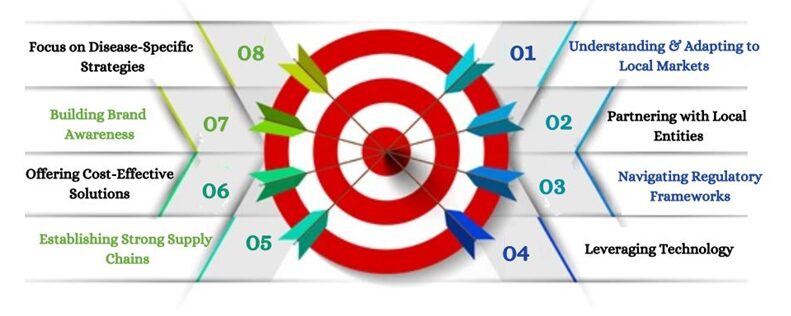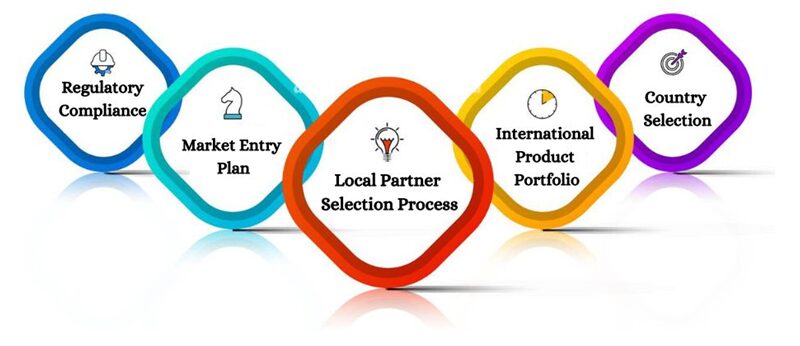Overview: Importance of Emerging Markets in the Global Pharmaceutical Industry
Emerging markets, including parts of Asia, Latin America, Africa, Tajikistan and Eastern Europe, are now vital to the global pharma sector. These regions offer a big growth opportunity for pharma firms. Their populations are large and growing fast. Economic development is advancing. Healthcare demands are rising.
Economic Expansion:
Many emerging markets have high GDP growth. This boosts healthcare spending and investments in medical infrastructure.
Changing Demographics:
High demand for healthcare solutions comes from a growing middle class, urbanization, and an aging population.
Unexploited Potential:
Emerging markets, unlike saturated ones in industrialized nations, are untapped for pharmaceuticals.
Why Emerging Markets Are Attractive for Pharma Expansion
Growing Middle-Class Population
The middle class is growing quickly in emerging markets thanks to economic growth and more job possibilities.
Richer families can spend more on health care. This includes preventive care, prescription drugs, and over-the-counter medicines.
In these areas, governments often subsidize middle-income families’ health care. This boosts demand for pharmaceutical products even more.
Rising Burden of Chronic Diseases
As lifestyles change, no communicable diseases (NCDs) are rising in many developing markets. These include diabetes, high blood pressure, obesity, and cancer.
City living and inactivity increase these diseases. So, people will need long-term meds and treatments.
Infectious diseases and chronic conditions affect many people at once. This gives companies a chance to create complete treatment solutions.
Government Healthcare Initiatives
Many governments in developing markets are prioritizing access to medical services and universal health care.
Programs like Ayushman Bharat in India and the Health Insurance Subsidy in Africa aim to help low-income people get needed medicines.
More government funding for healthcare makes it easier for drug companies to grow. This includes money for facilities, drug purchases, and insurance plans.
Key Challenges in Expanding Pharmaceutical Business in Emerging Markets
Regulatory Complexities
• It can be hard to figure out how to deal with the different rules that each growing market has.
• Delays in medicine approvals, rule changes, and varying standards can hinder new companies and slow market growth.
Distribution and Infrastructure Gaps
• Bad infrastructure, especially in rural places, makes it hard to set up supply chains that work well.
• Poor transport networks and limited cold chain logistics can hinder the delivery of drugs and lower their quality.
Pricing and Affordability Issues
• Companies must find cheap solutions because people in emerging countries are price-sensitive.
• It can be tough to balance low prices and profit, especially with government price controls and subsidies.
Cultural and Language Barriers
• It’s important to know the local language, health beliefs, and cultural norms in order to communicate and market effectively.
• Because people in some places don’t trust foreign companies, it may take a lot of work to build a brand reputation.
Top Strategies for Expanding Pharmaceutical Business
Understanding and Adapting to Local Markets
Do a market study to find out what the specific healthcare needs are in each area, then make sure that your products and strategies meet those needs. Talk to people in the area to learn about their cultural differences and healthcare goals.
Partnering with Local Entities
Leverage local businesses, wholesalers, and healthcare providers. Use their networks and market knowledge to your advantage. Partnerships and joint projects can help you get into new markets faster and build trust that lasts.
Navigating Regulatory Frameworks
Put together a legal compliance team to deal with the laws of each country and make sure that approvals and operations go smoothly. Actively work with governmental bodies to speed up the approval process.
Leveraging Technology
Use AI, analytics, and digital health tools to engage patients, speed up drug research, and improve operations. Track and improve supply lines with technology to cut costs and work more efficiently.
Establishing Strong Supply Chains
Build a local logistics system and strong relationships to make sure that products are delivered consistently and on time. Invest in cold storage and shipping facilities to keep the quality of your goods high.
Offering Cost-Effective Solutions
Make affordable Generic Medicine and biosimilars. Use tiered prices to help people of varying incomes. Help governments and non-governmental organizations (NGOs) give cheap medications to people who don’t have access to them.
Building Brand Awareness
To build credibility and visibility, run targeted marketing efforts. Also, join health programs run by the government and NGOs. Take part in programs that teach about public health to build trust and a good name.
Focus on Disease-Specific Strategies
Prioritize using customized treatments to address local health issues, like infectious diseases or chronic conditions. Invest in research and development to come up with new ways to solve health problems in your area.
Emerging Markets Offer Pharma Its Next Growth Opportunity
The pharma sector may flourish in developing countries. They have a growing middle class, a greater need for healthcare, and more government investment in health infrastructure. Many people in these areas are getting chronic diseases like diabetes and heart disease. This is changing how diseases spread. It creates a need for new, affordable treatments. Also, emerging economies often have untapped patient groups. This gives drug companies a chance to reach more people. Local manufacturing projects and study partnerships make it even easier to do business in these areas. In developed countries, drug firms face high prices and fierce competition. Emerging markets can help them earn more, lower risks, and grow. Pharma firms can tap into these areas’ huge potential. They must invest wisely and ensure their products meet local needs.
More Demand for Treatments catered to Local Population
• Increasing need for therapies targeting region-specific diseases and health issues.
• Formulating pharmaceuticals customized to regional genetic, environmental, and cultural influences.
• Heightened emphasis on tackling neglected tropical illnesses endemic to particular areas.
• Tailoring dose forms and delivery systems to accommodate regional preferences and infrastructure.
• Targeted therapy for lifestyle-related ailments is expanding in emerging markets.
• Regional R&D aimed at developing remedies for endemic infectious diseases.
• Increasing interest in therapies consistent with regional cuisine and lifestyle practices.
• Personalized medicine is being adopted to meet diverse health needs.
• Customized healthcare solutions targeting deficiencies in marginalized groups.
• Clinical trials must be region-specific to ensure safety and efficacy for local populations.
• Increasing focus on culturally competent healthcare interventions and education.
• Specialized production of pediatric and geriatric pharmaceuticals to address demographic needs.
• Mitigating inequities in healthcare access via tailored treatment options.
• Tailoring preventive care strategies to the specific risk factors of local populations.
Local Manufacturing and Research Opportunities
• Local manufacturing cuts costs, boosts supply chain efficiency and meets local content rules.
• Domestic manufacturing guarantees expedited delivery of pharmaceuticals and adherence to governmental regulations.
• Manufacturing facilities generate employment possibilities, cultivating goodwill and local collaborations.
• Collaboration with research institutions propels the advancement of therapies for region-specific ailments.
• Collaborating with local universities provides access to resources for new solutions.
• Local clinical trials accelerate drug approvals and enhance treatment accessibility.
• Government incentives and subsidies facilitate economical manufacturing and operational growth.
• Incorporating local suppliers fortifies supply chains and enhances the overall healthcare infrastructure.
• Technology transfer improves local manufacturing competencies and guarantees quality standards.
• Local production of low-cost generics enhances affordability for economically sensitive populations.
• Investing in regional research ecosystems builds a skilled workforce and drives innovation.
• Local production centers facilitate exports to adjacent markets, enhancing global competitiveness.
• Partnerships with governments on health projects enhance regional healthcare systems.
• Manufacturing and research in developing markets correspond with global healthcare needs.
Rethinking the Role of Emerging Pharmaceutical Markets
Emerging pharmaceutical markets are becoming innovation hubs and growth drivers. They are no longer just small players in the global healthcare scene. These markets are a great place to test new business ideas. For example, you could make things locally or use telemedicine to help those without access to medical care. They are also vital for diversifying global supply lines. It reduces the dangers of depending too heavily on advanced economies. Their research and partnerships with global firms are helping to find new drugs and reduce healthcare costs. Drug companies can grow by making these markets key to their global plan. They can also help solve important health problems worldwide.
What Pharma Companies Must Do to Thrive in Emerging Markets: Pharma Industry Experts at Infiniti Reveal Top Strategies
Pharmaceutical firms must adapt their strategy to local needs in expanding countries. They must ensure their products are affordable, accessible, and relevant. This entails establishing strategic alliances with local organizations to address regulatory obstacles and create distribution networks. Companies should invest in local manufacturing to cut costs and meet government rules. They should also focus R&D on local health issues. To succeed in these fast-growing markets, we must use technology to improve healthcare. We must also build strong connections with governments, providers, and patients.
5 Steps to a systematic approach to additional international success
1. International Product Portfolio
Develop a diversified portfolio that includes branded generics, biosimilars, and region-specific drugs.
2. Country Selection
Target markets with high growth, stable politics, and supportive regulations.
3. Market Entry Plan & Strategy
Choose entry modes, like direct investments or partnerships, based on market conditions and company goals.
4. Regulatory Compliance
Stay ahead of regulatory changes through continuous monitoring and strategic planning.
5. Systematic Local Partner Selection Process
Collaborate with trusted partners. They know the local market and can boost sales.
Emerging Markets: Key to Big Pharma Growth
Emerging economies are driving the next phase of growth in pharma. They offer great opportunities due to larger populations, rising middle-class incomes, and higher healthcare spending. These regions are shifting from infectious diseases to chronic ailments. There is a growing demand for new therapies and cheap generics. Pharma companies can use these markets to diversify their income. They can also form local alliances and engage in regional manufacturing and research. Pharmaceutical firms can achieve steady growth. They must meet regional health needs and navigate complex regulations.







































